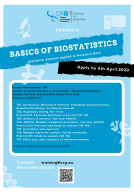 Basics of Biostatistics 2020: Statistical Analysis applied to Research Data
Basics of Biostatistics 2020: Statistical Analysis applied to Research Data

Registration HERE
Basics of Biostatistics 2020: Statistical Analysis applied to Research Data
Description:
The course will give an overview of important concepts and methods used to analyse “Biomedical data”. The emphasis will be on the understanding of statistical concepts and their interpretation in a research framework. After a general introduction on probability theory and statistical inference, an emphasis will be made on common statistical methods. Particular cases will be used as illustrative examples.
The course will be composed of face-to-face theoretical lectures combined with practical sessions and additional short homework assignment.
Teacher: Hafid Laayouni (UPF)
Duration: 10 sessions (total 20h)
Schedule: 17th/24th / 30th April | 8th/22nd /29th May | 5th/12th/19th/26th June (additional optional sessions (discussing and resolving exercises) will be scheduled for Thursdays 3-4pm).
Where: CRG Training centre (PRBB patio)
Maximum nº students: 19
Requirements: Participants need to have basic R programing skills
Application deadline: 6th of April 2020
| Title | Type | Date from 10:00-12:00 |
|---|---|---|
| Introduction. Descriptive statistics. Probability and distributions. Sampling distribution. Confidence intervals | Theory | 17th April 2020 |
| Hypothesis testing. The t-test. | Theory | 24th April 2020 |
| Exercises and Hands on sessions 1-2. | Practicum | 30th April 2020 |
| Analysis of variance. One-way ANOVA | Theory | 8th May 2020 |
| ANOVA. Multiple comparison procedures. Two-way ANOVA. | Theory | 22nd May 2020 |
| Hands on sessions 3-4. | Practicum | 29th May 2020 |
| Correlation and regression | Theory | 5th June 2020 |
| Multiple regression analysis. Partial correlation. | Theory | 12th June 2020 |
| Hands on sessions 7-8 | Practicum | 19th June 2020 |
| Effect Size and a summary of inference methods. | Theory | 26th June 2020 |
At the end of the course, the students will be able to:
- Express a scientific question in a mathematical formulation possible to analyse with statistical method.
- To be confident about sampling methods and their impact on the quality of the data.
- Think on the basis of experimental design: replication, randomization and stratification.
- Think about the appropriate statistical method given the data we have (dependent and/or independent variable, continuous or categorical variables).
- Have a deep understanding of the meaning and interpretation of a test statistic and how to construct own statistic given data.
- Have a correct understanding of key words in basic statistic: null hypothesis, alternative hypothesis, error type I, error type II, statistical power, observational study, experimental study, causation and correlation, sampling error, random error, systematic error, sampling distribution, p-value, statistical and practical significance, effect size, statistical power.
- Correct interpretation of the result of a statistical test and been aware of the limitations of the applied methods.
